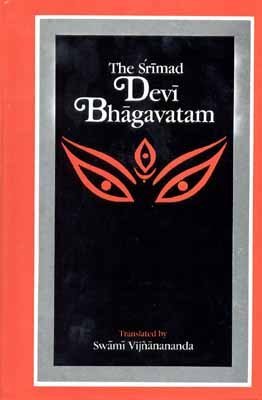The Devi Bhagavata Purana
by Swami Vijñanananda | 1921 | 545,801 words | ISBN-10: 8121505917 | ISBN-13: 9788121505918
The English translation of the Devi Bhagavata Purana. This Sanskrit work describes the Devi (Divine), the Goddess, as the foundation of the world and as identical with Brahman, the Supreme Being. The Devi Bhagavata Purana is one of the most important works in Shaktism, a branch of Hinduism focusing on the veneration of the divine feminine, along w...
Chapter 18 - On the narrative of Rāhu Maṇḍalam
1-9. Nārāyaṇa said :-- O Devarṣi! The Sphere of Rāhu (the ascending node) is situated one Ayuta Yoyanas below the Sun. Rāhu, the son of Simhikā is moving there like a Nakṣattra. This Rāhu swallows up both the Sun and the Moon and He has got immortality and capability to travel in the sky. The Sun’s rays go up to one Ayuta Yoyanas. The Asura Rāhu thus covers his rays. So the sphere of the Moon extends upto the twelve thousand Yoyanas. Rāhu covers the field of the thirteen thousand Yoyanas. So he covers both the Sun and the Moon. Desire to take the vengeance of the previous enmity, he covers them during the time of Parva (the festivals). This planet wants to cover them from a distance. Hearing this, the Bhagavān Viṣṇu hurls His Sudarśan Cakra against Rāhu. This Cakra (disc) is encircled with the fiery flames and is very terrible. When all the quarters were filled with its violent flames, Rāhu became instantly alarmed and fled away from the distance. O Devarṣi! This is known as the eclipse known amongst the mortals. Below the sphere of Rāhu, there are the other pure Lokas situated. O Sattama! The Siddhas, Cāraṇas, and Vidyādharas live in those Lokas. Their dimensions are one Ayuta Yoyanas.
10. O Devarṣi! Below them live the Yakṣas, Rākṣasas, Piśācas, Pretas and Bhūtas with their excellent Vihāras (residences).
11-34. The learned people call this Antarīkṣa. It extends upto where the wind blows violently and where the clouds appear. O Best of the twice-born! Below this Antarīkṣa is this earth, measuring one hundred Yoyanas. All the articles and things of the earth are found here; birds herons, cranes and ducks all fly over the earth. The earth extends upto this. Now is described the configuration of the earth. O Devarṣi! At the lower part of this earth there are seven places (caves or nether regions). Their diameter is one Ayuta Yoyanas. In all the seasons, all sorts of enjoyments can be had at these places. The first is Atala; the second is Vitala.
Next come in order :-- Sutala, Talātala, Mahātala. Rasātala, and lastly (the seventh) the Pātāla. O Vipra! Thus the seven holes or regions are reckoned. These are termed the Vila-Svargas and they yield the happinesses, greater than those of the Heavens. These are all filled with lovely amorous enjoyments, prosperity and happiness. They are crowded with gardens and Vihāras (the places of enjoyments). And these Vihāras are all decorated tastefully so as to furnish special tastes of enjoyments. The powerful Daityas, Dānavas, and Snakes enjoy here great happiness incessantly, united lovingly with their sons, wives and friends. The householders also pass their time in ease and enjoyments, surrounded by their friends and attendants. They are all Māyāvis (Magicians) and their resolves are not thwarted; they are more than God in this respect and they are filled with desires. They all live with joy and in enjoyments and they find pleasure in all the seasons. Māyā, the Lord of Māyā had built separate cities, as he liked, in those nether regions. Besides he has created thousands of dwelling-houses, palaces, and town-gates, studded with gems and jewels.
The assembly halls, Chatvaras, and Caityas are elaborately decorated and rare even to the Suras. The Nāgas and Asuras live in those houses with their consorts; doves and pigeons and female Mayinā birds are hovering there. In those places many plots marked out artificially and excellent rows of palatial buildings of the Lords of those Vivaras adorn there. Very big gardens also exist there. All these cheer the minds; and, to add to their beauty, many places of fruits and flowers are close by, fit for the comfort and enjoyments of the ladies. The tanks and pools of water are crowded with various birds; the lakes are filled with clear waters and the Pāṭhīna fishes abound there. The aquatic animals move in the waters, violently agitating them. Various kinds of lotuses, Kumud, Utpala, Kahlāra, blue lotus, red lotus, are fully blown in these lakes or reservoirs of water. The gardens there are all overcrowded with the Vihāras of the inhabitants there and echoed with the sweet melodious music, pleasing to the senses. For there, these places seem to vie with the Heavens. No fear is there, whether during the day or during the night. The gems on the crest of snakes constantly illumine the environments and there is no darkness there at any time. The food there is prepared with the divine medicines and they drink and bathe with these medicinal plants; so no disease attacks them. Old age, fever, indigestion, paleness, sweats, bad smells, or loss of energy or any other source of trouble cannot trouble them. The people are always happy and good. Only they fear the Teja of the Bhagavān and His Sudarśan disc; and they fear nothing else. When the Teja of the Bhagavān enters, the women’s abortions take place.
Here ends the Eighteenth Chapter of the Eighth Book on the narrative of Rāhu Maṇḍalam in the Mahāpurāṇam Śrī Mad Devī Bhāgavatam of 18,000 verses, by Maharṣi Veda Vyāsa.
